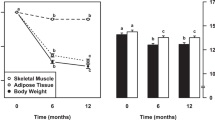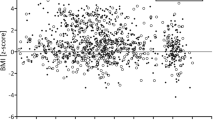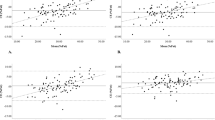Abstract
Objective: To examine the differences arising from indexing resting metabolic rate (RMR) against fat-free mass (FFM) determined using two-, three- and four-compartment body composition models.
Design: All RMR and body composition measurements were conducted on the same day for each subject following compliance with premeasurement protocols.
Subjects: Data were generated from measurements on 104 males (age 32.1±12.1 y (mean±s.d.); body mass 81.15±12.85 kg; height 179.5±6.5 cm; body fat 20.6±7.6%).
Interventions: Body density (BD), total body water (TBW) and bone mineral mass (BMM) were measured by hydrodensitometry, deuterium dilution and dual energy X-ray absorptiometry (DXA), respectively. These measures were used to determine two (hydrodensitometry: BD; hydrometry: TBW)-, three (BD and TBW)- and four- compartment (BD, TBW and BMM) FFM values. DXA also provided three compartment derived FFM values. RMR was measured using open circuit indirect calorimetry.
Results: Three (body fat group: lean, moderate, high) × five (body composition determination: hydrodensitometry, hydrometry, three-compartment, DXA, four-compartment) ANOVAs were conducted on FFM and RMR kJ.kg FFM−1.d−1. Within-group comparisons revealed that hydrodensitometry and DXA were associated with significant (P<0.001) overestimations and underestimations of FFM and RMR kJ.kg FFM−1.d−1, respectively, compared with four-compartment-derived criterion values. A significant interaction (P<0.001) resulted from DXA's greater deviations from criterion values in lean subjects. While hydrometric means were not significantly (P≥0.68) different from criterion values intraindividual differences were large (FFM: −1.5 to 2.9 kg; RMR: −6.0 to 3.2 kJ.kg FFM-1.d-1).
Conclusion: The relationship between RMR kJ.kg FFM−1.d−1 and exercise status would best be investigated using three (BD, TBW)- or four (BD, TBW, BMM)-compartment body composition models to determine FFM. Other models either significantly underestimate indexed RMR (hydrodensitometry, DXA) or display large intraindividual differences (hydrometry) compared with four-compartment derived criterion values.
Sponsorship: Australian Research Council (small grants scheme).
This is a preview of subscription content, access via your institution
Access options
Subscribe to this journal
Receive 12 print issues and online access
$259.00 per year
only $21.58 per issue
Buy this article
- Purchase on Springer Link
- Instant access to full article PDF
Prices may be subject to local taxes which are calculated during checkout




Similar content being viewed by others
References
Baumgartner RN, Heymsfield SB, Lichtman SL, Wang J & Pierson J (1991): Body composition in elderly people: effect of criterion estimates on predictive equations. Am. J. Clin. Nutr. 53, 1345–1353.
Berke EM, Gardner AW, Goran MI & Poehlman ET (1992): Resting metabolic rate and the influence of the pretesting environment. Am. J. Clin. Nutr. 55, 626–629.
Broeder CE, Burrhus KA, Svanevik LS & Wilmore JH (1992): The effects of either high-intensity resistance or endurance training on resting metabolic rate. Am. J. Clin. Nutr. 55, 802–810.
Brozek J, Grande F, Anderson JT & Keys A (1963): Densitometric analysis of body composition: revision of some quantitative assumptions. Ann. NY Acad. Sci. 110, 113–140.
Clasey JL, Kanaley JA, Wideman L, Heymsfield SB, Teates CD, Gutgesell ME, Thorner MO, Hartman ML & Weltman A (1999): Validity of methods of body composition assessment in young and older men and women. J. Appl. Physiol. 86, 1728–1738.
Cote KD & Adams WC (1993): Effect of bone density on body composition estimates in young adult black and white women. Med. Sci. Sports Exerc. 25, 290–296.
Elia M (1992), Organ and tissue contribution to metabolic rate. In Energy metabolism: Tissue Determinants and Cellular Corollaries. eds JM Kinney & HM Tucker pp 63–76. New York: Raven Press Ltd..
Elia M & Livesey G (1992): Energy expenditure and fuel selection in biological systems: The theory and practice of calculations based on indirect calorimetry and tracer methods, In Metabolic Control of Eating, Energy Expenditure and the Bioenergetics of Obesity. World Review of Nutrition and Dietetics. ed. AP Simopoulos, pp 68–131. Basel: Karger.
Frey-Hewitt B, Vranizan KM, Dreon DM & Wood PD (1990): The effect of weight loss by dieting or exercise on resting metabolic rate in overweight men. Int. J. Obesity Relat. Metab. Disord. 14, 327–334.
Friedl KE, Deluca JP, Marchitelli LJ & Vogel JA (1992): Reliability of body fat estimations from a four-compartment model by using density, body water, and bone mineral measurements. Am. J. Clin. Nutr. 55, 764–770.
Gallagher D, Heymsfield SB, Heo M, Jebb SA, Murgatroyd PR & Sakamoto Y (2000): Healthy percentage body fat ranges: an approach for developing guidelines based on body mass index. Am. J. Clin. Nutr. 72, 694–701.
Goran MI & Poehlman ET (1992): Endurance training does not enhance total energy expenditure in healthy elderly persons. Am. J. Physiol. 263, E950–E957.
Goran MI, Toth MJ & Poehlman ET (1998): Assessment of research-based body composition techniques in healthy elderly men and women using the 4-compartment model as a criterion method. Int. J. Obesity Relat. Metab. Disord. 22, 135–142.
Kohrt WM (1995): Body composition by DXA: tried and true? Med. Sci. Sports Exerc. 27, 1349–1353.
LaForgia J, Withers RT, Shipp NJ & Gore CJ (1997): Comparison of energy expenditure elevations after submaximal and supramaximal running. J. Appl. Physiol. 82, 661–666.
LaForgia J, Withers RT, Williams AD, Murch BJ, Chatterton BE, Schultz CG & Leaney F (1999): Effect of 3 weeks of detraining on the resting metabolic rate and body composition of trained males. Eur. J. Clin. Nutr. 53, 126–133.
Mendez J, Keys A, Anderson JT & Grande F (1960): Density of fat and bone mineral of the mammalian body. Metabolism 9, 472–477.
Modlesky CM, Cureton KJ, Lewis RD, Prior BM, Sloniger MA & Rowe DA (1996): Density of the fat-free mass and estimates of body composition in male weight trainers. J. Appl. Physiol. 80, 2085–2096.
Mole PA (1990): Impact of energy intake and exercise on resting metabolic rate. Sports Med. 10, 72–87.
Penn I-W, Wang Z-M, Buhl KM, Alison DB, Burastero SE & Heymsfield SB (1994): Body composition and two-compartment model assumptions in male long distance runners. Med. Sci. Sports Exerc. 26, 392–397.
Poehlman ET & Danforth E (1991): Endurance training increases metabolic rate and norepinephrine appearance rate in older individuals. Am. J. Physiol. 261, E233–E239.
Poehlman ET, Gardner AW & Goran MI (1992): Influence of endurance training on energy intake, norepinephrine kinetics, and metabolic rate in older individuals. Metabolism 41, 941–948.
Poehlman ET, Melby CL & Badylak SF (1988): Resting metabolic rate and postprandial thermogenesis in highly trained and untrained males. Am. J. Clin. Nutr. 47, 793–798.
Pratley R, Nicklas B, Rubin M, Miller J, Smith A, Smith M, Hurley B & Goldberg A (1994): Strength training increases resting metabolic rate and norepinephrine levels in healthy 50- to 65-yr-old men. J. Appl. Physiol. 76, 133–137.
Prior BM, Cureton KJ, Modlesky CM, Evans EM, Sloniger MA, Saunders M & Lewis RD (1997): In vivo validation of whole body composition estimates from dual-energy X-ray absorptiometry. J. Appl. Physiol. 83, 623–630.
Ravussin E & Bogardus C (1989): Relationship of genetics, age, and physical fitness to daily energy expenditure and fuel utilization. Am. J. Clin. Nutr. 49, 968–975.
Ryan AS, Pratley RE, Elahi D & Goldberg AP (1995): Resistive training increases fat-free mass and maintains RMR despite weight loss in postmenopausal women. J. Appl. Physiol. 79, 818–823.
Siconolfi SF, Gretebeck RJ & Wong WW (1995): Assessing total body protein, mineral, and bone mineral content from total body water and body density. J. Appl. Physiol 79, 1837–1843.
Siri WE ed. (1961): Body composition from fluid spaces and density: analysis of methods, In Techniques for Measuring Body Composition. ed. JBA Henschel, pp 223–224. Washington, DC: National Academy of Sciences National Research Council.
Smith DA, Dollman J, Withers RT, Brinkman M, Keeves JP & Clark DG (1997): Relationship between maximum aerobic power and resting metabolic rate in young adult women. J. Appl. Physiol. 82, 156–163.
Smith DA, Withers RT, Brinkman M, Tucker RC, Chatterton BE, Schultz CG & Clark DG (1999): Resting metabolic rate, body composition and aerobic fitness comparisons between active and sedentary 54–71 year old males. Eur. J. Clin. Nutr. 53, 434–440.
van der Ploeg GE, Brooks AG, Withers RT, Dollman J, Leaney F & Chatterton BE (2001a): Body composition changes in female bodybuilders during preparation for competition. Eur. J. Clin. Nutr. 55, 268–277.
van der Ploeg GE, Gunn SM, Withers RT, Modra AC & Crockett AJ (2000): Comparison of two hydrodensitometric methods for estimating percent body fat. J. Appl. Physiol. 88, 1175–1180.
van der Ploeg GE, Gunn SM, Withers RT, Modra AC, Keeves JP & Chatterton BE (2001b): Predicting the resting metabolic rate of young Australian males. Eur. J. Clin. Nutr. 55, 145–152.
van der Ploeg GE & Withers RT (2002): Predicting the resting metabolic rate of 30–60 year-old Australian males. Eur. J. Clin. Nutr. 56, 701–708.
van der Ploeg GE, Withers RT & Laforgia J (2003): Percent body fat via DEXA: comparison with a four-compartment model. J. Appl. Physiol 94, 499–506.
Visser M, Gallagher D, Deurenberg P, Wang J, Pierson RN & Heymsfield SB (1997): Density of the fat-free body mass: relationship with race, age, and level of body fatness. Am. J. Physiol. 272, E781–E787.
Westerterp KR, Meijer GAL, Janssen EME, Saris WHM & Hoor FT (1992): Long-term effect of physical activity on energy balance and body composition. Br. J. Nutr. 68, 21–30.
Withers RT, LaForgia J & Heymsfield SB (1999): Critical appraisal of the estimation of body composition via two-, three-, and four-compartment models. Am. J. Hum. Biol. 11, 175–185.
Withers RT, LaForgia J, Pillans RK, Shipp NJ, Chatteron BE, Schultz CG & Leaney F (1998a): Comparisons of two-, three-, and four-compartment models of body composition analysis in men and women. J. Appl. Physiol. 85, 238–245.
Withers RT, Noell CJ, Whittingham NO, Chatterton BE, Schultz CG & Keeves JP (1997): Body composition changes in elite male bodybuilders during preparation for competion. Aust. J. Sci. Med. Sport 29, 11–16.
Withers RT, Smith DA, Tucker RC, Brinkman M & Clark DG (1998b): Energy metabolism in sedentary and active 49- to 70-yr-old women. J. Appl. Physiol. 84, 1333–1340.
Author information
Authors and Affiliations
Contributions
Guarantor: J LaForgia.
Contributors: JLF, GEV, SMG and AGB recruited the subjects, collected and analysed the data; JLF, RTW and GEV conceived and wrote the paper; BEC supervised the DXA scans.
Corresponding author
Rights and permissions
About this article
Cite this article
LaForgia, J., van der Ploeg, G., Withers, R. et al. Impact of indexing resting metabolic rate against fat-free mass determined by different body composition models. Eur J Clin Nutr 58, 1132–1141 (2004). https://doi.org/10.1038/sj.ejcn.1601941
Received:
Revised:
Accepted:
Published:
Issue Date:
DOI: https://doi.org/10.1038/sj.ejcn.1601941
Keywords
This article is cited by
-
Estimating the agreement between the metabolic rate calculated from prediction equations and from a portable indirect calorimetry device: an effort to develop a new equation for predicting resting metabolic rate
Nutrition & Metabolism (2018)
-
Influence of methods used in body composition analysis on the prediction of resting energy expenditure
European Journal of Clinical Nutrition (2007)
-
Protein and Overtraining: Potential Applications for Free-Living Athletes
Journal of the International Society of Sports Nutrition (2006)



